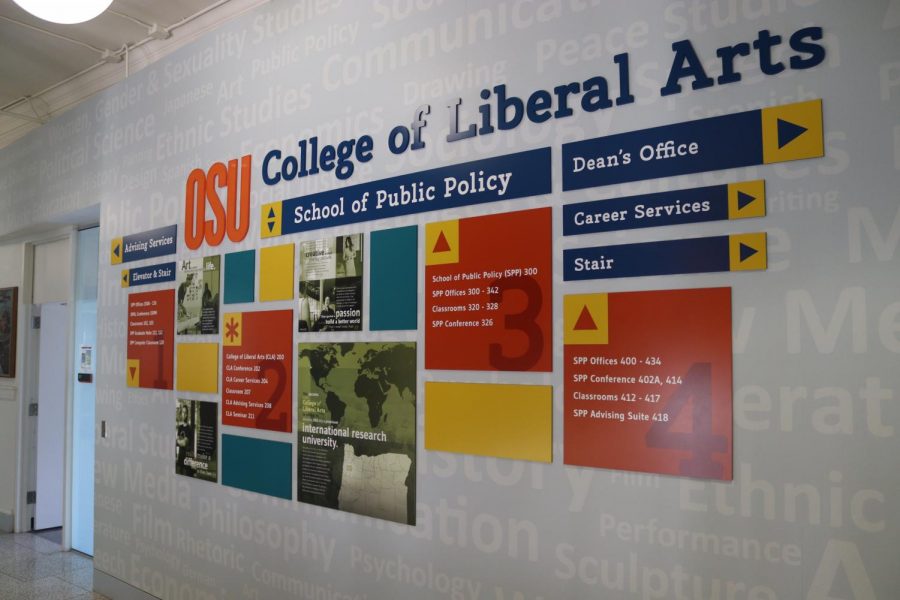Board of Trustees approve changes to organization of School of Arts and Communication, among other agenda items
August 4, 2021
Oregon State University’s School of Arts and Communication within the College of Liberal Arts has been approved to separate into two distinct schools: a School of Communication and a School of Visual, Performing and Design Arts.
The OSU Board of Trustees agreed in a meeting on Tuesday—with a strong endorsement from Provost Edward Feser—to reorganize the School of Arts and Communication with the goal of developing a stronger sense of alignment and structure within the College of Liberal Arts.
Currently, the School of Arts and Communication is split into the programs of art, graphic design, music, digital communication arts, speech communication and theatre arts.
“There are basically two schools at work in this existing organizational structure, but right now we only have the administrative capacity for one,” Colin Hesse, interim director of the School of Arts and Communication, said. “We want to expand that to two to allow for proper oversight of all six areas [of the School of Arts and Communication] in a way that makes more sense.”
Recalling his time on a panel for the School of Arts and Communication around two or three years ago, Hesse said that they attempted to host a discussion of a shared vision between all six areas of the School of Arts and Communication, and it proved “exceedingly difficult to try to combine some of the social-scientific areas of speech communication with areas of art and graphic design and music.”
The separation of the School of Arts and Communication is proposed to be effective as of Fall 2021.
“This move really helps focus the possible visions and goals surrounding both undergraduate and graduate programs for both potential new schools,” Hesse said.
In addition to the structural change within the College of Liberal Arts, the board moved to approve the creation of a new baccalaureate degree in contemporary music industry that will be offered through the School of Visual, Performing and Design Arts upon successful completion of the reorganization of the School of Arts and Communication.
Assistant Professor Dana Reason and Vice Provost for Undergraduate Education Alix Gitelman presented the proposal to the board. Gitelman said this program will only be available fully online via Ecampus at this point.
“The goal of this program is to really connect today’s music lovers, makers and cultural thinkers about music with the four-year college experience,” Reason said. “Our program gives people the opportunity to start connecting with professional faculty [and for] people in the industry to learn about the ways in which you can have a viable, profitable and engaged life in contemporary music.”
Although prior music training is not required, students will be required to submit an entrance survey and work samples that will provide OSU faculty with the ability to determine potential within the student population as well as determine specialization within the program.
Her goal is to connect students with faculty immediately rather than focus only on music theory.
“We know that programs of this nature that are offered on the East Coast are very full, up to 400 or 500 people in these programs,” Reason said. “Right now, I am [estimating that the cohort size will] be 170.”
The major is currently pending approval of the Statewide Provosts Council and Higher Education Coordinating Commission with the goal of becoming effective in winter 2022.
The board also approved another project on Tuesday and passed a budget of $5 million dedicated to the Capital Project Stage Gate II: Hatfield Marine Science Center Research Seawater System Renewal with an annual estimated cost of around $477,458.
“The seawater system is one of Hatfield’s core assets,” said OSU HMSC Director Bob Cowen. “It is really important to the quality of research that is done at Hatfield. In that context, it reaches not only to the researchers, the graduate students and our undergraduates, but also the public. It distinguishes us from most other marine facilities in the quantity and quality of seawater that we can provide.”
To highlight the importance of the seawater system, Cowen said the Alaska Fishery Science Center—which is part of the National Oceanic and Atmospheric Administration—houses a lab at the HMSC, located in Newport, Ore, because of the quality of seawater.
“We pump up to a million gallons of fresh seawater through 57,000-square-feet of labs,” Cowen said. “That’s nine different buildings… The potential loss that would occur is highly impactful. It’s something we’re really proud of, [and] it’s something that puts us on the map nationally and internationally as well.”
Because of anticipated vacancies in at-large positions on the board, Interim OSU President Rebecca L. Johnson presented Gayle Fitzpatrick and Maria Teresa Chávez-Haroldson as potential candidates for the positions.
Fitzpatrick is currently the vice president of Global Technical Support at New Relic located in Lake Oswego, Ore.
“We believe Fitzpatrick would be an excellent addition to our pool of candidates,” Johnson said. “She brings a strong knowledge of Oregon State University, she has board leadership experience, she has volunteer experience in higher education and really has immediate leadership potential for our board.”
Johnson said Chávez-Haroldson would also be an outstanding addition to the pool. Currently, Chávez-Haroldson is the equity, diversity and inclusion director and migrant education services coordinator with the Willamette Education Service District.
“Chávez-Haroldson brings a history of leading equity, inclusion and diversity initiatives. She has experience across the pre-K through post-secondary education continuum and volunteer experience engaging with youth at the local and national levels which makes her very well-suited as a potential trustee.”
Fitzpatrick and Chávez-Haroldson were approved by the board, and are now pending Governor Kate Brown’s approval for the additions.
“I personally am really delighted at the outstanding quality of the entire pool of candidates, including the two we are approving today,” Chair Rani Borkar said. “Very much looking forward to the governor’s decision, and whoever gets appointed, we look forward to working with them.”
























































































































